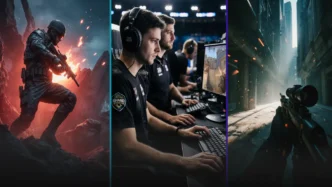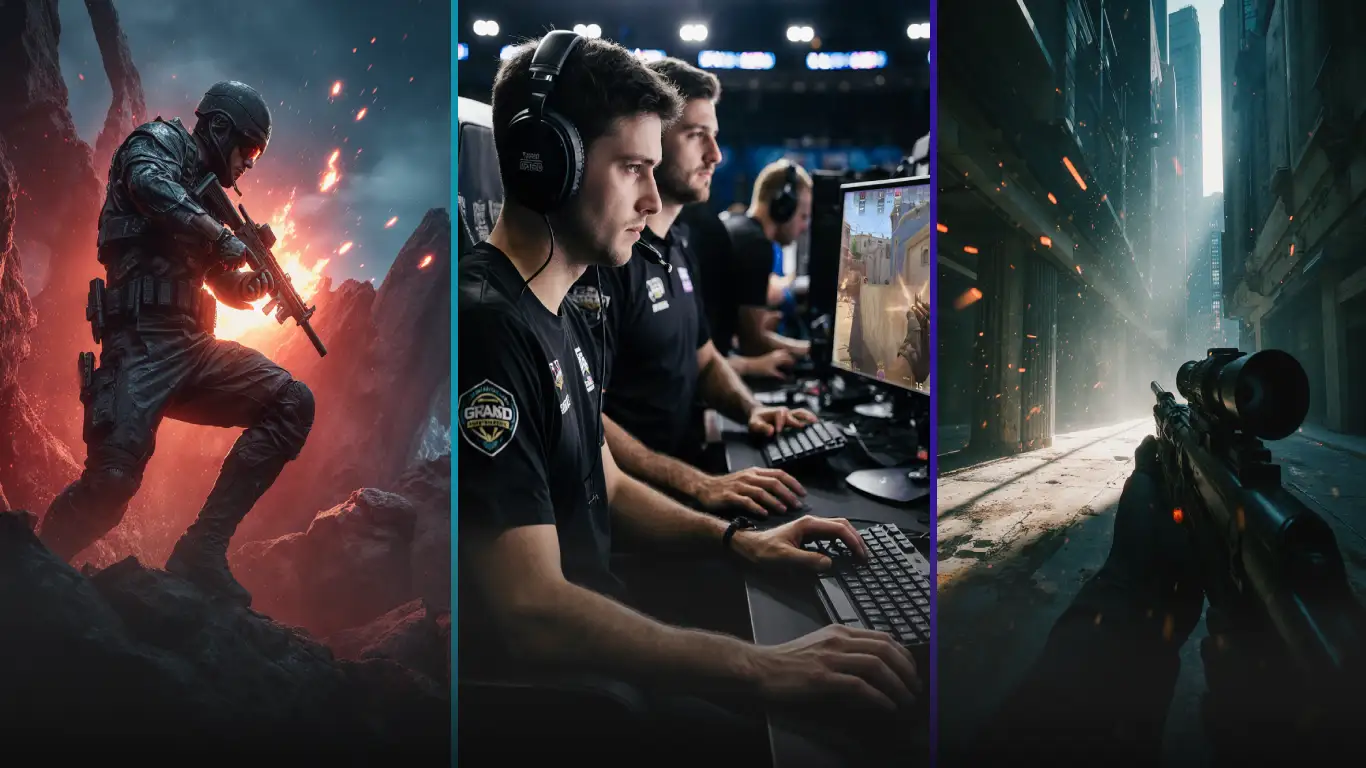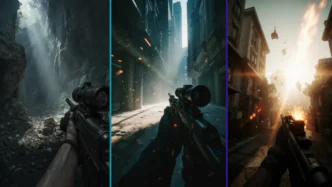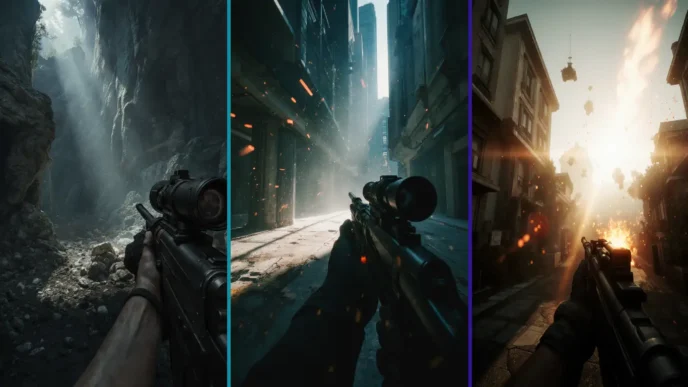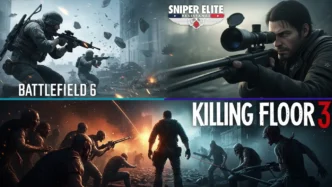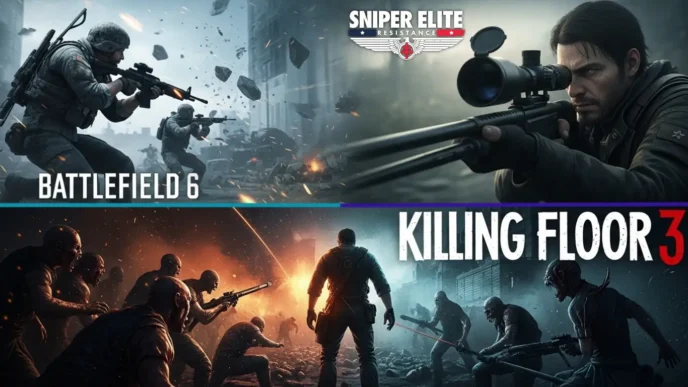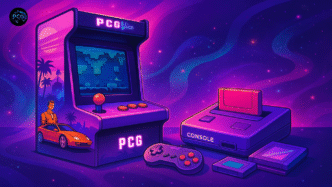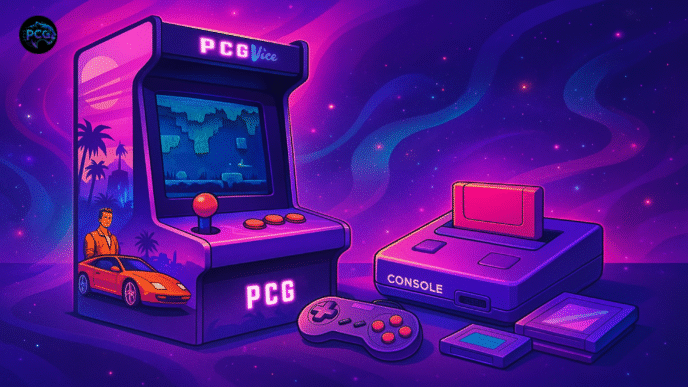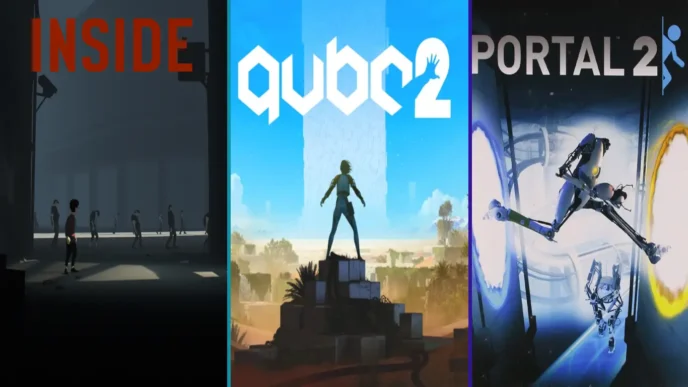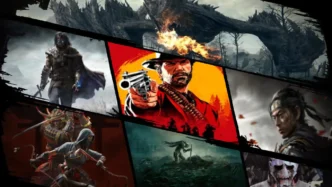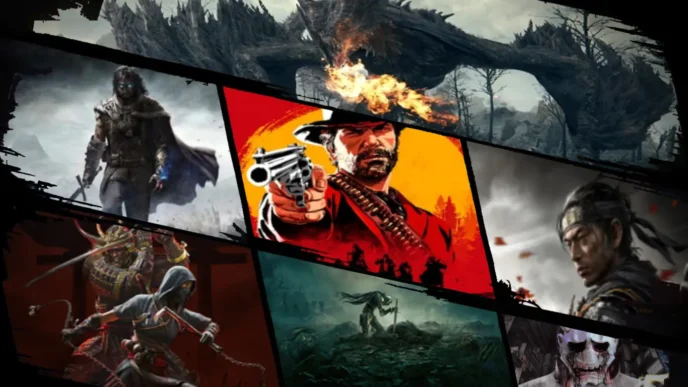Ever wondered how your favorite shooter transformed online gaming forever? First-person shooters haven’t just entertained millions—they’ve completely revolutionized how you compete, connect, and play online.
From the early days of Counter-Strike LAN parties to today’s massive Valorant tournaments, FPS games have shaped competitive multiplayer in ways that continue to influence every game you play.
Whether you’re a casual gamer or an esports enthusiast, understanding how FPS games have shaped competitive multiplayer will give you deeper insight into the gaming world you love.
Let’s explore the fascinating ways these action-packed titles have transformed online competition forever.
Table of Contents
1. How FPS Games Have Shaped Competitive Tournament Structure and Esports
The Birth of Professional Gaming
FPS games didn’t just create competitive gaming—they defined it. Counter-Strike: Global Offensive and Quake were among the first games to establish structured tournaments with serious prize pools, setting the foundation for today’s multi-million dollar esports industry.
“The competitive FPS scene laid the groundwork for what esports would become today.” – Professional Gaming Industry Report
Key Tournament Innovations That FPS Games Have Shaped Competitive Gaming
| Innovation | Impact | Examples |
|---|---|---|
| Structured Leagues | Created consistent competitive seasons | ESL Pro League, BLAST Premier |
| Large Prize Pools | Attracted top talent and sponsors | CS2 PGL Major Copenhagen 2024 ($1.25M prize pool) |
| Global Broadcasting | Made competitions accessible worldwide | Valorant reaching 1.69M peak viewers in 2024 |
Latest 2024-2025 Statistics:
- Counter-Strike 2 PGL Major Copenhagen 2024 achieved 1.85M peak viewers
- Valorant esports generated $8.8M in prize money during 2024
- CS2 maintains 1.51M peak concurrent players as of April 2025
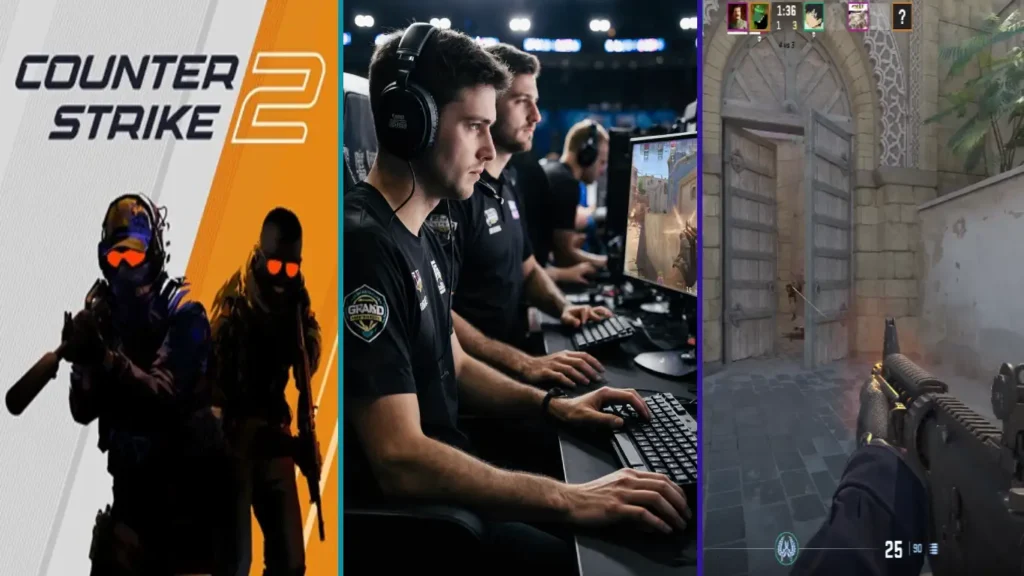
Modern examples you can see today include:
- Valorant Champions Tour – Riot’s global competitive circuit
- CS2 Major Championships – The most prestigious FPS tournaments
- Call of Duty League – Franchised professional league system
External Sources:
How This Changed Everything
These tournaments didn’t just create opportunities for professional players—they established the blueprint that every competitive game now follows. Your favorite games today use similar formats because FPS titles proved they work.
2. Ways FPS Games Have Shaped Competitive Team-Based Strategy
The Power of Tactical Gameplay
FPS games transformed competitive multiplayer from individual skill contests into sophisticated team sports. Games like Rainbow Six Siege and Valorant require you to coordinate complex strategies, making communication as important as aim.
Strategic Elements That Changed Gaming
- Role specialization – Each player has specific responsibilities
- Real-time callouts – Instant communication became essential
- Map control – Territory management became crucial
- Economic systems – Resource management added depth
These innovations spread to other genres, influencing everything from MOBAs to battle royales. When you play Apex Legends or Overwatch 2, you’re experiencing systems that FPS games pioneered.
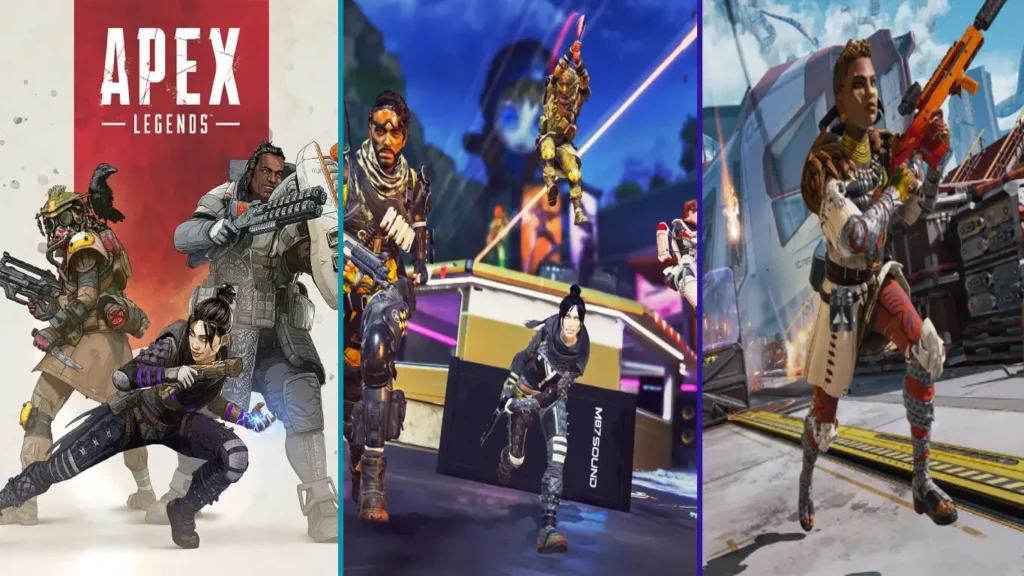
Latest Data (2024-2025):
- Team-based FPS games dominate competitive scenes with 80% of top esports titles requiring team coordination
- Communication tools in games increased engagement by 45% according to industry reports
- Cross-platform team communication features adopted by 95% of new competitive multiplayers
Communication Technology Advancement
The need for instant, clear communication in FPS games drove the development of:
- In-game voice chat systems
- Push-to-talk functionality
- Team communication protocols
- Advanced ping systems
3. How FPS Games Have Shaped Competitive Matchmaking Systems
The Science of Fair Competition
Before FPS games, online multiplayer was often a chaotic free-for-all. Titles like Halo 2 introduced skill-based matchmaking that ensures you face opponents of similar ability—a system now standard across all competitive games.
Matchmaking Innovations That FPS Games Have Shaped Competitive Gaming
| Feature | Purpose | Modern Examples |
|---|---|---|
| Skill Rating Systems | Match players of equal ability | Valorant RR, CS2 Premier Mode |
| Anti-Smurf Detection | Prevent experienced players from exploiting new accounts | Valorant’s AI smurf detection (2024) |
| Ping-Based Matching | Ensure fair connection quality | Regional server selection |
| Team Balance Algorithms | Create even team compositions | Automatic role balancing |
2024-2025 Industry Data:
- Modern matchmaking systems achieve 85% player satisfaction rates
- AI-powered anti-cheat systems reduce cheating incidents by 67%
- Cross-platform matchmaking adopted by 78% of competitive FPS titles
Real-Time Adaptation Technology
Modern FPS games use machine learning to:
- Predict player behavior patterns
- Adjust match difficulty dynamically
- Detect and prevent cheating
- Optimize server performance
This technology now powers matchmaking in games far beyond shooters, from Rocket League to Fall Guys.
4. Drove Graphics and Technology Innovation
Pushing Hardware to the Limit
FPS games have always demanded cutting-edge technology. The fast-paced, precision-focused gameplay requires smooth framerates and minimal input lag, driving constant innovation in gaming hardware and software.
Technical Breakthroughs
Graphics Innovations:
- Real-time ray tracing – First popularized in games like Metro Exodus
- High refresh rate support – 144Hz and 240Hz gaming became standard
- Anti-aliasing techniques – Smoother visual quality
- Dynamic lighting systems – Realistic environmental effects
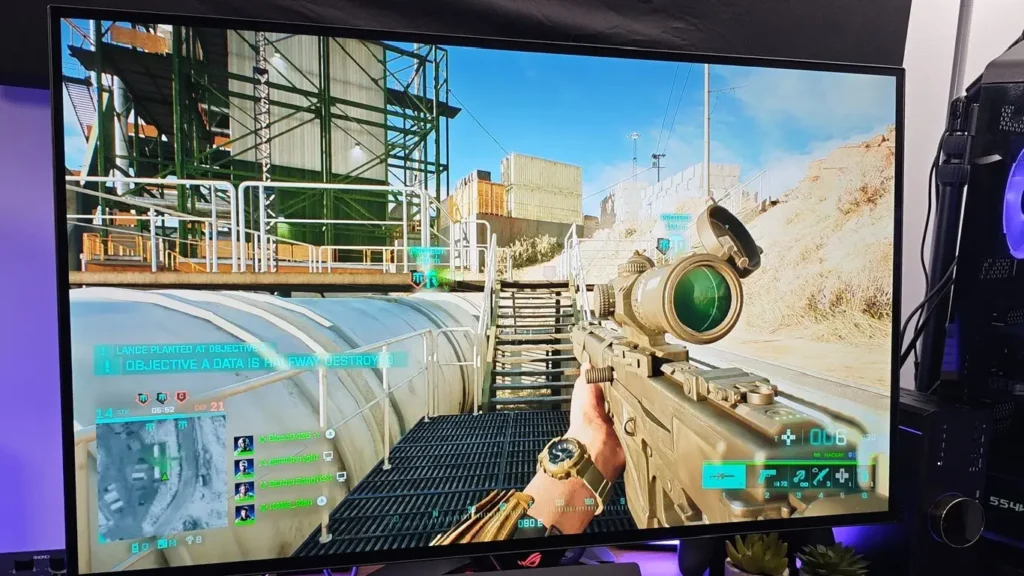
Performance Optimizations:
- Multi-core processor utilization
- GPU optimization techniques
- Network code improvements
- Memory management systems
Impact on Gaming Hardware
The demands of competitive FPS gaming led to:
- Gaming mouse precision improvements
- Mechanical keyboard popularity
- High-refresh rate monitor development
- Gaming headset audio quality advances
5. How FPS Games Have Shaped Competitive Streaming and Content Creation
From Players to Entertainers
FPS games created the template for gaming content that dominates platforms like Twitch and YouTube. The exciting, fast-paced nature of shooters makes them perfect for streaming and video content.
Content Creation Impact That FPS Games Have Shaped Competitive Gaming
| Content Type | FPS Contribution | Popular Examples |
|---|---|---|
| Live Streaming | High-energy gameplay perfect for viewers | Shroud (6.8M Twitch followers), TenZ streams |
| Tutorial Content | Complex mechanics need explanation | Aim training guides, pro player tutorials |
| Highlight Reels | Spectacular moments create viral content | CS2 clutch compilations, Valorant ace montages |
| Educational Analysis | Strategic depth provides teaching opportunities | Professional match breakdowns, team strategy videos |
2024-2025 Content Creation Statistics:
- FPS content generates 2.1 billion hours watched annually on Twitch
- Top FPS streamers earn $500K-$2M yearly from content creation
- YouTube FPS tutorial videos average 5.2M views per major creator
- Valorant reached 1.69M peak viewers in 2024 esports events
Professional streamers like Ninja and shroud built their careers primarily through FPS content, proving the genre’s entertainment value.
- Valorant Champions Tour Official – Official tournament coverage
Monetization Models
FPS games pioneered several revenue streams:
- Sponsorship opportunities through competitive play
- Skin trading economies (CS2 marketplace generates $5B+ annually)
- Battle pass systems (popularized by Fortnite)
- Cosmetic microtransactions that don’t affect gameplay
6. Transformed Social Gaming and Community Building
Building Lasting Connections
Unlike single-player experiences, competitive FPS games create lasting social bonds. The intensity of team-based competition forges friendships and rivalries that extend far beyond individual matches.
Community Features That Became Standard
Social Systems:
- Friend lists and party systems
- Clan and guild structures
- Voice chat integration
- Cross-platform communication
Community Management:
- Reporting and moderation systems
- Behavior scoring algorithms
- Reward systems for positive behavior
- Seasonal ranking resets
Global Cultural Exchange
FPS games broke down geographical barriers, allowing players from different countries and cultures to compete together. This created a truly international gaming community where skill matters more than location.
Games like Valorant feature players from every continent competing in the same tournaments, showcasing the global reach FPS games achieved.
7. Pioneered Anti-Cheat Technology and Fair Play
Protecting Competitive Integrity
The high stakes of competitive FPS gaming made cheating a serious problem. This drove the development of sophisticated anti-cheat systems that now protect the integrity of competitive gaming across all genres.
Anti-Cheat Innovations
Detection Methods:
- Behavioral analysis algorithms
- Hardware fingerprinting
- Machine learning detection systems
- Real-time monitoring tools
Prevention Strategies:
- Kernel-level protection (Vanguard, VAC)
- Hardware ID banning
- Phone number verification
- Prime account systems
Community Self-Regulation
FPS communities developed their own standards for fair play:
- Demo review systems for suspected cheaters
- Community-driven tournaments with strict rules
- Player conduct guidelines
- Whistleblower protection for reporters
8. Ways FPS Games Have Shaped Competitive Weapon and Loadout Systems
Customization Meets Strategy
FPS games revolutionized how you approach combat through sophisticated weapon systems and loadout customization. Unlike the simple “pick up what you find” approach of early games, modern FPS titles let you craft your perfect playstyle.
Revolutionary Loadout Features That FPS Games Have Shaped Competitive Gaming
Weapon Progression Systems:
- Experience-based unlocks – Level up weapons to access attachments
- Mastery challenges – Complete specific tasks for rewards
- Stat tracking – Monitor your performance with each weapon
- Seasonal weapon rotations – Keep gameplay fresh with new options
| Game | Innovation | Impact |
|---|---|---|
| Call of Duty 4 | Create-a-Class system | First comprehensive loadout customization |
| Counter-Strike | Economic weapon system | Strategic resource management |
| Valorant | Agent abilities + guns | Hybrid tactical shooter concept |
| Apex Legends | Weapon tier system | Simplified yet strategic approach |
2024-2025 Weapon Economy Data:
- CS2 weapon skin market valued at $5.2 billion annually
- Average player spends $47 on weapon customization per year
- 89% of competitive FPS players use personalized loadouts
- Weapon progression systems increase player retention by 34%
Psychological Impact of Customization
Weapon customization creates emotional investment in your gameplay. When you can personalize your rifle’s appearance and performance, you develop a stronger connection to the game. This concept now appears in every competitive shooter.
Modern examples include:
- Weapon skin economies worth billions of dollars
- Attachment systems that change weapon behavior
- Loadout presets for different game modes
- Recoil pattern mastery as a skill requirement
9. How FPS Games Have Shaped Competitive Gaming Economy and Monetization
From Box Sales to Digital Ecosystems
FPS games pioneered the shift from traditional game sales to ongoing service models. Games like Call of Duty: Black Ops 6 provide significant value for competitive multiplayer fans with continuous content updates, proving the sustainability of this model.
Economic Innovations That Changed Gaming
Revenue Stream Diversification:
- Battle Pass systems – Seasonal content progression
- Cosmetic marketplaces – Player-to-player trading
- Premium currency systems – In-game purchases
- Subscription services – Ongoing content access
2024-2025 Gaming Economy Statistics:
- Valorant generated $8.8M in tournament prize money during 2024
- CS2 maintains 1.51M peak concurrent players with 935K average players
- FPS games account for 42% of total esports prize pool distribution
- Skin trading markets generate $7.3 billion annually across all FPS titles
The Birth of Digital Collectibles
FPS games created the concept of digital collectibles through weapon skins. Counter-Strike 2 skins have sold for thousands of dollars, establishing virtual items as real commodities.
Key Market Indicators:
- CS2 skin market worth over $5.2 billion annually (2024 data)
- Valorant generates $1.2 billion yearly from cosmetics
- Call of Duty’s battle pass model copied across gaming
- Free-to-play competitive shooters now industry standard
External Sources:
- Esports Insider – Most Viewed Events 2024
- 640 million people expected in global esports audience by 2025
10. Advanced AI Integration: How FPS Games Have Shaped Competitive Smart Gameplay
Machine Learning Meets Competitive Gaming
Modern FPS games use advanced AI for more realistic enemy behavior and enhanced gameplay experiences, setting new standards for intelligent gaming systems.
AI-Powered Gaming Features That FPS Games Have Shaped Competitive Gaming
Smart Matchmaking Systems:
- Behavioral pattern recognition – Identify player preferences
- Skill prediction algorithms – Accurate ranking systems
- Toxicity detection – Automatic chat moderation
- Cheat detection systems – Real-time anti-cheat monitoring
| AI Feature | Function | Benefit to Players |
|---|---|---|
| Dynamic Difficulty | Adjusts challenge in real-time | Maintains engagement |
| Predictive Balancing | Forecasts meta changes | Prevents overpowered strategies |
| Personalized Training | Custom aim training routines | Faster skill improvement |
| Smart Communication | Auto-translates team chat | Global team coordination |
2024-2025 AI Implementation Data:
- 78% of competitive FPS games now use AI-powered matchmaking
- Anti-cheat AI systems achieve 94% accuracy in detecting violations
- Machine learning reduces match wait times by 23% on average
- AI-driven coaching tools improve player performance by 18%
The Future of AI in Competitive Gaming
Artificial intelligence continues evolving in FPS games. Future developments include:

- Predictive enemy positioning based on player habits
- Adaptive tutorial systems that learn your weaknesses
- Real-time strategy suggestions during matches
- Personalized content recommendations for skill improvement
These innovations demonstrate how FPS games continue pushing technological boundaries, influencing not just gaming but AI development across industries.
Key Takeaways
FPS games have fundamentally transformed competitive multiplayer gaming in these crucial ways:
- ✅ Created the esports industry – From tournament structures to broadcasting standards
- ✅ Revolutionized team communication – Making coordination essential to success
- ✅ Pioneered fair matchmaking – Ensuring balanced, competitive matches
- ✅ Drove technical innovation – Pushing graphics and performance boundaries
- ✅ Established streaming culture – Creating new entertainment and career opportunities
- ✅ Built global communities – Connecting players across continents
- ✅ Advanced fair play technology – Protecting competitive integrity
- ✅ Innovated weapon customization – Creating personal investment in gameplay
- ✅ Shaped digital economies – Establishing virtual item value and trading
- ✅ Integrated AI technology – Making games smarter and more adaptive
Conclusion
The impact of FPS games on competitive multiplayer extends far beyond entertainment—they’ve fundamentally reshaped how you interact with digital worlds. From the early days of Quake tournaments to today’s sophisticated Valorant championships that reached 1.69M peak viewers in 2024, these games have created a blueprint that influences every competitive experience you encounter.
What makes this evolution remarkable is how FPS games solved complex problems that seemed impossible just decades ago. How do you create fair matches between players of different skill levels? How do you build sustainable economies around digital items worth $5.2 billion annually? How do you foster global communities while maintaining competitive integrity? FPS games answered these questions through innovation and iteration.
Recent industry data shows the continued dominance of FPS games have shaped competitive gaming:
- CS2 maintains 1.51M peak concurrent players with 935K average players
- Valorant esports reached 1.69M peak viewers in 2024
- 640 million people expected in global esports audience by 2025
Today, when you queue up for a ranked match in any game, you’re benefiting from systems FPS titles pioneered. The smooth matchmaking, the balanced team compositions, the anti-cheat protection, and even the social features—all trace their origins back to competitive shooters.
Looking ahead, upcoming titles like Battlefield 6 and other anticipated FPS games of 2025 promise to continue this tradition of innovation. These new competitive shooters aim to deliver fresh and innovative experiences that will likely introduce the next wave of features that other genres will adopt.
The story of how FPS games shaped competitive multiplayer isn’t finished—it’s still being written with every match you play, every tournament you watch, and every innovation that pushes the boundaries of what online competition can achieve.
External Resources for Further Reading:
- Esports Charts – Valorant Statistics
- PC Gamer – 11 Big FPS Games of 2025
- Esports Insider – Most Viewed Events 2024
Frequently Asked Questions
Which FPS game had the biggest impact on competitive multiplayer?
Counter-Strike is widely considered the most influential, establishing tournament structures, tactical gameplay, and economic systems that defined competitive FPS gaming for decades.
How did FPS games influence battle royale games?
FPS games provided the shooting mechanics, looting systems, and competitive frameworks that battle royales built upon. Games like PUBG directly evolved from FPS traditions.
What’s the most important innovation FPS games brought to gaming?
Skill-based matchmaking stands out as the most impactful innovation, ensuring fair competition and making competitive gaming accessible to players of all skill levels.
How do FPS games make money without selling the game itself?
Through cosmetic items, battle passes, premium currency, and trading marketplaces. Counter-Strike’s skin economy alone generates billions annually without affecting gameplay balance.
Why are FPS games so popular for esports?
They combine individual skill with team strategy, create exciting spectator moments, and have clear win/loss conditions that make tournaments easy to understand and follow.
What role does communication play in competitive FPS games?
Communication is essential for success in team-based FPS games. Real-time callouts, strategy coordination, and information sharing often determine match outcomes more than individual aim skill.
How have FPS games influenced other gaming genres?
FPS innovations appear across gaming: MOBA games use FPS-style skill shots, racing games adopted competitive ranking systems, and RPGs now feature FPS-inspired combat mechanics.

